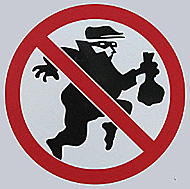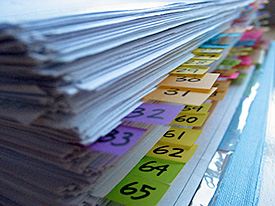Using your sources responsibly
In some cultures reproducing the words of an authority is perfectly acceptable. In Western society, however, great importance is attached to individual creativity and originality. Every 'creation of the mind' is considered the creator's intellectual property.
Intellectual property rights, very broadly, are rights granted to creators and owners of works that are the result of intellectual creativity. The main intellectual property rights are patents, trade marks, design rights, and copyright.
Copyright explained

'Copyright' by Marla Elena (via Flickr). Licensed under CC BY 2.0.
An important concept in using information in an ethical way is copyright -- the exclusive right given by law for a certain term of years to an author or creator, to print, publish, and sell copies of his/hers original work. Copyright is obtained automatically without the need for registration or other formalities. The unauthorized use of copyrighted material is considered infringement -- which is a violation.
Important to know: copyrighted works don't need to display the copyright symbol: ©.
Copyright law doesn't give copyright holders complete control of their works. When the copyright term expires, copyrighted works move into the 'public domain' -- which means that they are available for unlimited use by the public. In most countries, including the Netherlands, copyright terms last for the life of the creator, plus 70 years.
The exclusive rights of the copyright owner are not unlimited, though. Even before copyrighted works enter the public domain, the public is free to make use of them -- for certain purposes.
Limitations & exceptions to copyright
Different countries have different rules about when it's acceptable to use material without getting permission from the copyright owner. In the United States, the 'fair use' doctrine permits the use of portions of copyright-protected works under certain circumstances without the copyright owner's consent. These circumstances include commentary, criticism, research, teaching, and news reporting. Some other countries have a similar doctrine called 'fair dealing'.
Copyright in the European Union, however, doesn't have a general underlying principle such as fair use/dealing. Everything tends to fall under copyright unless it is covered by a specific exception in the national law of the member states. In the Netherlands, exceptions to copyright include: quoting or paraphrasing small portions of a work for commentary or criticism (with proper attribution), news reporting, and parody.
NOTE
In your paper, you may use copyrighted images only as part of your argument, i.e. for comment and analysis (provided, of course, that you give credit to the creator). If you wish to use an image for decoration only, you will need to request permission from the copyright owner.Creative Commons licenses
In the last decade, many authors and other creators have begun using Creative Commons (CC) licenses, which allow others to use their work in certain ways without asking permission. For example, RefCite is licensed under CC-BY-NC (Creative Commons Attribution-Non-Commercial-No Derivative Works), which allows its content to be copied, adapted, displayed, distributed, republished or otherwise re-used for noncommercial use.
Note that CC licenses are not an alternative to copyright. They work alongside copyright, modifying the copyright terms to best suit the author's / creator's wishes. It's still essential that you reference the source of CC-licensed material in your work, otherwise you may be infringing the terms of the copyright, and you will definitely be plagiarizing!
Plagiarism: theft of intellectual property
Whenever you use material from an outside source, whether you use the exact words or not, you must document credit the source. Failing to do so constitutes plagiarism, which means you have taken someone else's material and used it as if it were your own.
On its student website, Tilburg University defines plagiarism as follows:
"using parts of a text written by someone else, or the reasoning or ideas of others for a thesis or other assignment, without due acknowledgement."
Plagiarism is wrong, dishonest, and can lead to serious negative consequences. Students found guilty of plagiarism can expect sanctions ranging from failing a course to being excluded from taking exams for the next semester or academic year.
Common forms of plagiarism
Plagiarism can take many forms. Here are some examples:

'Burglar + Bag' by John (via Flickr). Licensed under CC BY-NC-ND 2.0.
- submitting work written by someone else as if it were one's own.
- translating somebody else's work into a different language and present it as one's own.
- paying someone to create a custom-written paper ('ghost writing').
- submitting almost exactly the same paper for two different different classes (self-plagiarism).
- copying text from websites (or retyping text from print sources).
- having someone edit one's paper by adding/replacing a few words or phrases.
- providing incorrect or inadequate information about a source, making it impossible for the reader to locate the source.
- including an image, diagram, or table from another source without due acknowledgement.
- using someone's exact words without quotation marks and without citing the source.
- replacing words in someone else's work with synonyms while maintaining the same overall structure ('close paraphrasing').
Avoiding accidental plagiarism
In some cases plagiarism is obviously deliberate, for example when a student cuts and pastes together a paper from a variety of sources without proper attribution. But there are other times where honest students plagiarize out of ignorance, not because they purposely want to cheat.
Accidental plagiarism happens when students don't have the academic skills to avoid over-reliance on their sources, or because they don't understand exactly what plagiarism is. Other students are just poorly organized while gathering their sources and end up using the words of others unintentionally.How to avoid accidental plagiarism?
- Correctly use your sources
- Quote, paraphrase, and summarize in a clear and honest way every time you include a source in your text.
- Provide a reference for each source (including your own work if submitted before).
- Be accurate in note-taking
- Use a consistent and accurate note-taking system in which you clearly indicate when you are quoting or paraphrasing from a source and when you are recording your own thoughts about your topic; highlight source material, use quotation marks or a different font color.
- Make a list of all sources as you consult them. Record relevant source details (author(s), book and article titles; URLs). This will save time and effort later, and will also help prevent your forgetting which sources you've consulted.
NOTE
Most lecturers at Tilburg University are using some kind of plagiarism detection software to check students' papers.
Copyright vs. plagiarism
Plagiarism and copyright each address the legitimacy of copying, but plagiarism and copyright differ in important ways. While plagiarism is concerned with the protection of ideas, copyright doesn't protect ideas –- it protects 'fixed expressions of ideas.'
Plagiarism is the act of misrepresenting the ownership of an idea. In academia, it means passing off someone else's ideas as your own in a research paper or other academic work. One way to avoid plagiarism is to properly cite your sources –- a key academic skill.
By contrast, copyright is a legal concept extensively embodied by copyright law and policies. Copyright lawpermits individuals to make copies under certain conditions, but violating certain copyright rules is copyright infringement. You can't avoid a copyright infringement claim just by citing your sources!



